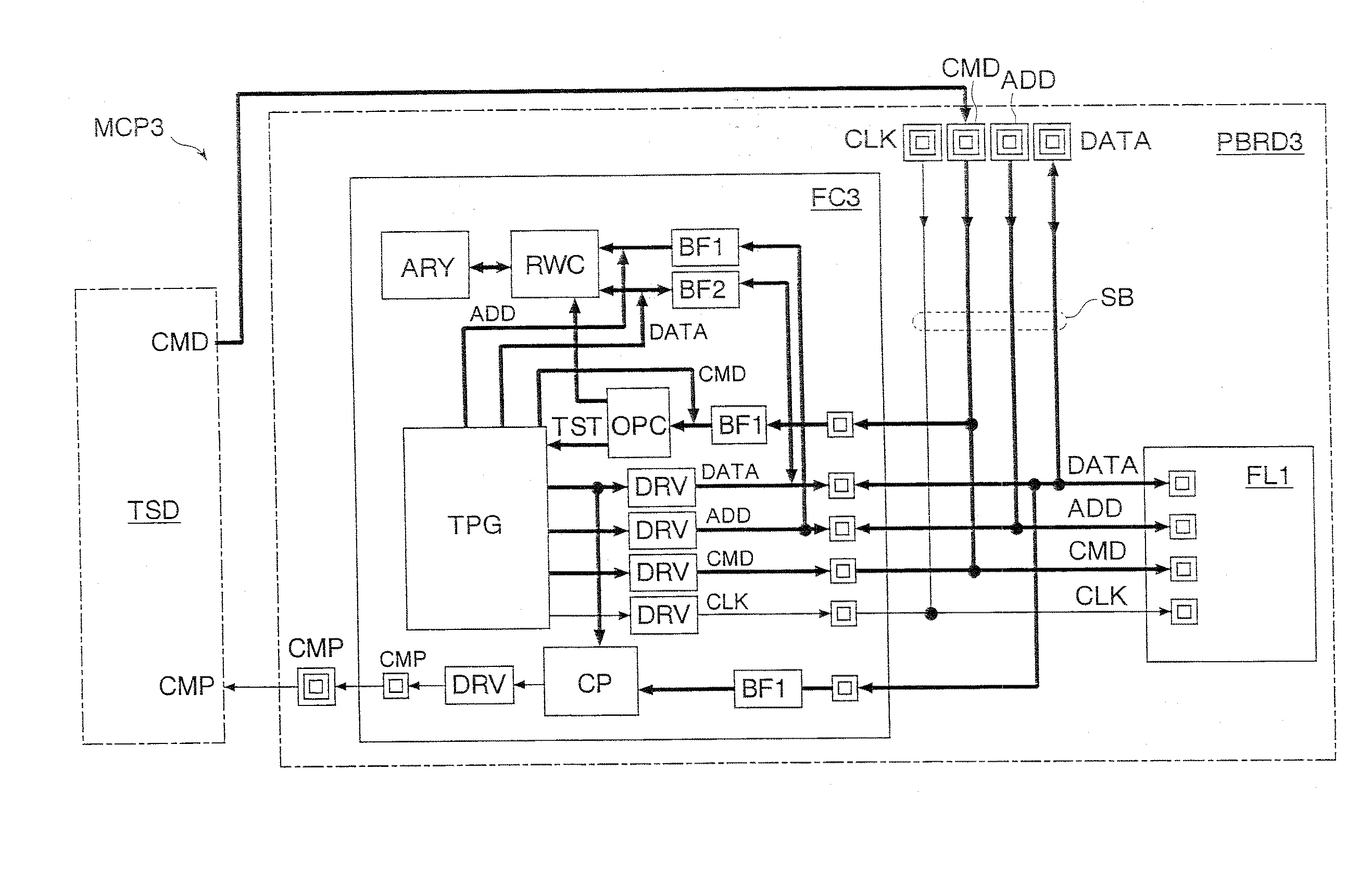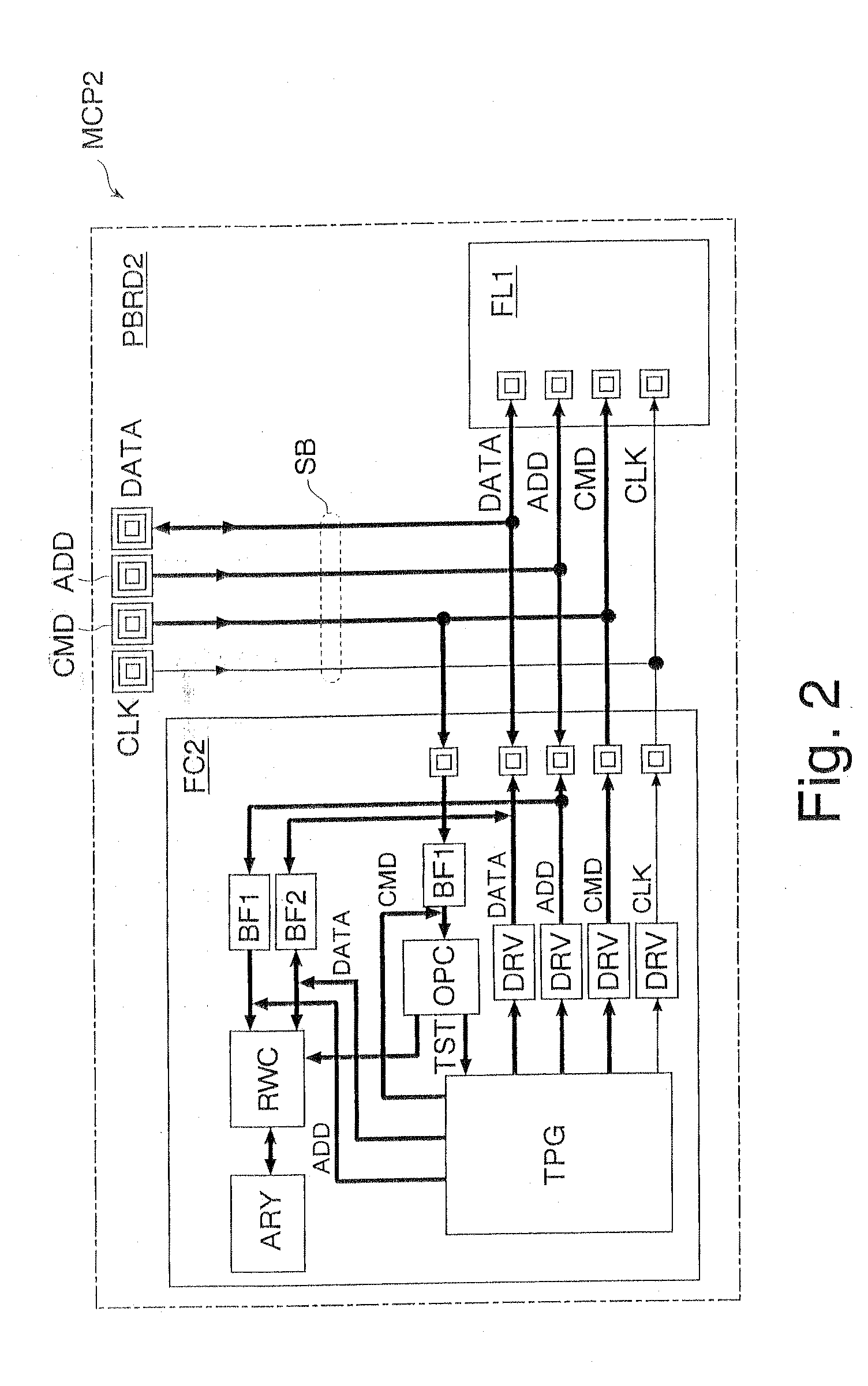Semiconductor memory, system, testing method for system
a memory and semiconductor technology, applied in the field of system testing technology, can solve the problems of reducing test efficiency, difficult for the manufacturer to distribute logic data, and complicated test patterns for memory chips, so as to reduce the test cost of a system
- Summary
- Abstract
- Description
- Claims
- Application Information
AI Technical Summary
Benefits of technology
Problems solved by technology
Method used
Image
Examples
first embodiment
[0039]FIG. 1 shows a In this embodiment, an FCRAM chip FC1 (Fast Cycle RAM: first memory chip) and a flash memory chip FL1 (second memory chip) are mounted on a package board PBRD1 to form a multi-chip package MCP1 (system). The MCP1 is mounted, for example, in portable equipment such as a mobile phone. The FCRAM chip FC1 has a DRAM memory core and is a kind of pseudo SRAM chip having an SRAM interface. The FCRAM chip FC1 operates asynchronously with a clock and the flash memory chip FL1 operates synchronously with a clock. The FCRAM chip FC1 and the flash memory chip FL1 are also called a chip FC1 and a chip FL1 respectively below.
[0040] The chip FC1 has a memory cell array ARY having volatile memory cells (dynamic memory cells), a read / write control circuit RWC, a plurality of buffers BF1 and BF2, an operation control circuit OPC, a test pattern generator TPG, a plurality of drivers DRV, and a plurality of pads. The read / write control circuit RWC receives during write operation a...
second embodiment
[0057] The chip FC3 has, in addition to the configuration of the chip FC2 in the second embodiment, pads (external input terminals) connected successively, the buffer BF1, a comparator CP, the driver DRV, and the test result terminal CMP (pad). The comparator CP compares test write data for the chip FL1 output from the test pattern generator TPG and test read data read from the chip FL1 into which the test write data has been written via the buffer BF1, and outputs a comparison result to the test result terminal CMP via the driver DRV. The test result terminal CMP is a dedicated terminal for outputting a test result signal CMP indicating the test result.
[0058] The package board PBRD3 is the same as the package board PBRD2 in the second embodiment except that pattern wiring and connection specifications (bonding specifications) are different to connect a data line DATA of the system bus SB to a pad corresponding to the comparator CP and a test result terminal CMP (a system-test conne...
third embodiment
[0061] Also in the third embodiment, as described above, an effect similar to that of the above embodiments can be obtained. Further, the test result terminal CMP is formed on the chip FC3 and the package board PBRD3 in the present embodiment and therefore, the testing apparatus TSD can determine whether the MCP3 is a good product or a bad one based solely on a test result transmitted to the test result terminal CMP without reading data from the chips FC1 and FL1. Thus, the testing apparatus TSD can be configured by a simple circuit. As a result, test costs can be reduced.
[0062] Further, also when many MCP3's are mounted on the evaluation board, signals required for the testing apparatus TSD are only the test command signal CMD common to a plurality of MCP3's and the test result signal CMP required for each MCP3. Many MCP3's can be tested at a time due to the simple testing apparatus TSD and therefore, the test time and test costs can significantly be reduced.
PUM
 Login to View More
Login to View More Abstract
Description
Claims
Application Information
 Login to View More
Login to View More - R&D
- Intellectual Property
- Life Sciences
- Materials
- Tech Scout
- Unparalleled Data Quality
- Higher Quality Content
- 60% Fewer Hallucinations
Browse by: Latest US Patents, China's latest patents, Technical Efficacy Thesaurus, Application Domain, Technology Topic, Popular Technical Reports.
© 2025 PatSnap. All rights reserved.Legal|Privacy policy|Modern Slavery Act Transparency Statement|Sitemap|About US| Contact US: help@patsnap.com



